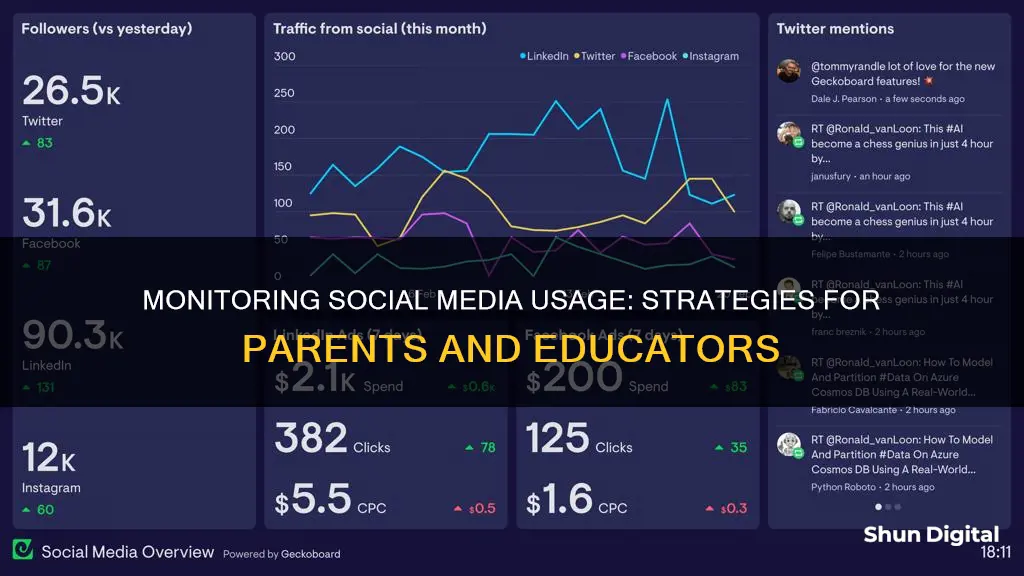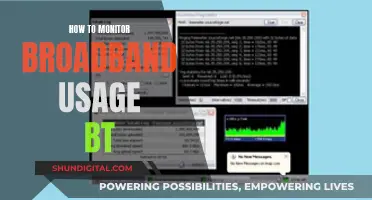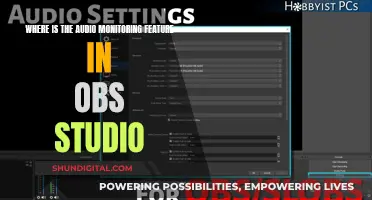
Social media has become an integral part of our lives, offering a platform for connection and expression. However, excessive usage has been linked to adverse effects such as addiction, cyberbullying, and mental health issues. To address this, individuals can utilise built-in phone features or third-party apps to monitor and reduce their social media usage. This includes setting app usage limits, turning off notifications, and engaging in alternative activities. Additionally, for businesses, monitoring social media conversations is crucial for brand management, customer engagement, and identifying trends. Various tools are available to help track mentions, analyse sentiment, and discover new opportunities.
| Characteristics | Values |
|---|---|
| Purpose | Connect with customers, provide customer support, measure social media reach, understand social media trends, and boost brand awareness |
| Tools | Hootsuite, Sprout Social, Agora Pulse, Zoho Social, Brand24, Mention, Keyhole, Iconosquare, Tailwind, Sendible, Meltwate, HubSpot, Reputation, Brandwatch, Talkwalker, Social Fever, Cleverest, YourHour, Offtime, StayFree, Stay Focused, Freedom, Flipd, SPACE, QualityTime, Digital Detox |
| Features | Monitoring multiple profiles and platforms, tracking keywords, hashtags, and URLs, scheduling and analytics, real-time updates, customizable blocking features, daily usage limit settings, cross-platform sync, sentiment analysis, tracking trends, identifying influencers, etc. |
What You'll Learn

Track direct mentions of your brand and links to your campaigns
Tracking direct mentions of your brand and links to your campaigns is a crucial aspect of social media monitoring. Here are some detailed instructions and tips to help you effectively monitor these mentions and links:
Choose the Right Tools
Select social media monitoring tools that fit your specific needs. Look for tools that can track mentions across all relevant social media platforms and provide real-time insights. Some popular tools include Sprout Social, Google Alerts, and Prowly's Media Monitoring tool. These tools can help you automate the process of monitoring brand mentions and provide valuable analytics.
Set Up Alerts and Notifications
Create alerts for your brand name and any relevant variations or misspellings. This ensures that you're notified whenever someone mentions your brand, even if they don't use the exact spelling or name. You can also set up alerts for specific campaigns or links by tracking the URLs associated with them.
Monitor Across All Platforms
Don't limit your monitoring efforts to just one or two social media platforms. Customers can mention your brand on any platform, so it's important to cast a wide net. Use tools that can monitor multiple platforms simultaneously, ensuring you don't miss out on important conversations or feedback.
Respond and Engage Authentically
Social media monitoring is not just about collecting mentions; it's also about engaging with your audience. Respond to both positive and negative mentions authentically and with purpose. Thank customers for their feedback, address any concerns or complaints, and use the insights gained to improve your products or services.
Analyze and Adjust
Regularly analyze the data and insights gathered from social media monitoring. Compare the results with your initial goals and objectives to evaluate the effectiveness of your monitoring strategy. If needed, adjust your approach, such as changing the types of posts you share or the timing of your responses, to better align with your goals.
Monitor Backlinks and Unlinked Mentions
In addition to direct brand mentions, keep track of backlinks (links to your website from third-party sources) and unlinked mentions (where your brand is mentioned but not linked to). These can be powerful indicators of your brand's reach and reputation. Reach out to publishers or influencers who mention your brand positively, and work on improving any negative sentiments.
Track Industry-Specific Publications
Monitor industry-specific publications and websites to stay informed about any mentions of your brand or campaigns within your industry. This can help you capitalize on positive press and share it with your audience, as well as stay ahead of any potential issues or negative sentiments within your industry.
By following these steps and staying proactive in your social media monitoring, you can effectively track direct mentions of your brand and links to your campaigns, allowing you to build a strong online presence and positively shape your brand's reputation.
Monitoring Disk Usage: Strategies for Efficient Data Management
You may want to see also

Monitor relevant keywords for your brand
Monitoring relevant keywords for your brand is a crucial aspect of social media tracking and can provide valuable insights to improve your business. Here are some detailed steps and tips to help you monitor relevant keywords effectively:
Identify Keywords
The first step is to create a list of keywords that are relevant to your brand. This should include your brand name, any variations, and potential misspellings. For example, if your brand is Coca-Cola, you should track both "Coca-Cola" and "Coke". Include product names, catchphrases, slogans, and industry-specific terminology that customers might use.
Monitor Competitors
In addition to tracking your brand, monitor your competitors' brands, products, and services. This provides valuable insights into their social media strategies and helps you identify opportunities for social selling. Monitor their websites, social media posts, and industry-related conversations to stay informed about their activities.
Track Industry Hashtags and Keywords
Identify and track industry-specific hashtags and keywords that are relevant to your brand. For example, if you're in the wedding photography business, track hashtags like #weddingphotographer. This will help you join relevant conversations and increase brand exposure.
Monitor Across All Platforms
Don't limit your monitoring efforts to just one or two social media platforms. Customers can mention your brand on any platform, so it's important to cast a wide net. Use tools that can monitor multiple platforms simultaneously to ensure you don't miss any critical insights or mentions.
Respond and Engage
Monitoring relevant keywords isn't just about collecting data; it's also about actively participating in conversations. Respond to both positive and negative mentions, addressing concerns, and showing appreciation for compliments. This helps build stronger relationships with your customers and increases brand loyalty.
Analyze and Adjust
Finally, analyze the data you've collected through social media monitoring to identify patterns and trends. Are there certain types of posts or content that generate more engagement? What are the sentiments of your customers, and how can you improve their experience? Use these insights to adjust your social media strategy and create more effective content.
By following these steps and continuously refining your approach, you'll be able to effectively monitor relevant keywords for your brand and make data-driven decisions to improve your social media presence and marketing strategies.
Monitoring Employee Web Usage: Strategies for Effective Surveillance
You may want to see also

Respond to social media mentions
Responding to social media mentions is an integral part of any social media strategy. Here are some tips to help you respond effectively:
- Respond promptly: Customers expect timely responses from brands on social media. A quick response demonstrates your brand's attentiveness and commitment to customer care.
- Move the conversation to a private setting: If a customer has a complaint or issue, it's often best to move the conversation to a more private location, such as a direct message or email. This allows you to protect your brand's reputation, safeguard the customer's personal information, and provide a more personalized experience.
- Stay positive and empathetic: Even when responding to negative mentions, maintain a respectful and professional tone. Respond empathetically, acknowledge their concerns, and offer solutions. Remember, a negative mention is an opportunity to turn a customer's experience around and showcase your brand's commitment to resolving issues.
- Know when to stop responding: If a conversation is not heading in a productive direction, or if a customer is unsatisfied despite your best efforts, know when to disengage gracefully. Create an escalation protocol for your internal case management to handle such situations effectively.
- Engage in conversations: Go beyond simply saying "thank you." Engage with your audience by asking questions, seeking clarifications, and providing additional insights. This demonstrates your brand's commitment to interacting with its customers and creating value.
- Maintain your brand's voice and tone: Ensure that the team member(s) responding to mentions are experts in your brand's voice and tone. Whether it's marketing or customer service, your brand's style should be well-aligned and consistent. Use clear, simple language that is accessible to everyone.
Electricity Usage: Are Police Monitoring Your Power Consumption?
You may want to see also

Monitor across all platforms
Monitoring social media usage across all platforms is essential for a comprehensive understanding of your audience and industry. Here are some strategies and tools to achieve this:
- Identify Relevant Platforms: Recognize the social media platforms that are most relevant to your target audience and industry. While it's important to monitor across all platforms, focusing your efforts on the spaces where your audience is most active will yield the most valuable insights.
- Utilize Social Media Monitoring Tools: Various tools are available, such as Sprout Social, Hootsuite, and Agorapulse, that enable you to track mentions, keywords, and metrics across multiple platforms. These tools consolidate data from different networks into a single dashboard, making it easier to manage and respond to social interactions.
- Monitor Relevant Keywords: Identify and track keywords that are relevant to your brand, industry, and competitors. This includes brand names, variations, product names, competitor brands, and industry-specific terminology. By monitoring these keywords across all platforms, you can join relevant conversations and gain valuable insights.
- Respond to Mentions and Conversations: Social media monitoring involves actively participating in or observing conversations. Respond to both positive and negative mentions, addressing customer inquiries, complaints, and compliments. This helps build relationships and improve customer satisfaction.
- Analyze and Adjust: Regularly analyze the data and insights gathered from social media monitoring. Evaluate key metrics such as engagement rate, sentiment analysis, and social share of voice. Based on your findings, adjust your social media strategies, content approaches, and response techniques to improve your online presence and better serve your audience.
- Mobile Applications: Mobile apps such as Moment, RescueTime, Offtime, Forest, and Space can help monitor and reduce screen time and social media usage. They provide features like app usage tracking, notifications, and customizable profiles to help users develop healthier digital habits.
Monitoring Data Usage: Mediacom's Essential Guide
You may want to see also

Set alerts for unusual activity
Setting up alerts for unusual activity is a crucial aspect of social media monitoring. Here are some ways to do this effectively:
Sensitive Keywords and Topics:
Monitor for sensitive keywords and topics that could cause issues for your brand. For example, keep an eye out for controversial topics or negative sentiments associated with your brand. Use social media tools to detect sudden increases in these keywords and respond promptly to address customer concerns and protect your reputation.
Spike in Negative Sentiment:
Leverage sentiment analysis tools to detect a rise in negative sentiment. This could be due to various reasons such as product recalls, customer service issues, or negative press coverage. It's important to address negative sentiment quickly and efficiently by using monitoring tools and having clear protocols for response.
Severe Events and Safety Issues:
Actively monitor for mentions of safety issues, health issues, severe allergy reactions, and other alarming events. This demonstrates your brand's commitment to customer safety and satisfaction.
Broken Links:
Keep an eye out for broken links in your social media posts. These issues can harm your online presence and frustrate potential customers. Address broken links quickly to show your dedication to providing a seamless user experience.
Typos and Errors:
Effectively manage typos and errors in your social media content. Consider acknowledging the mistake and taking immediate action to correct it. Depending on the context, using humor or creativity can show the human side of your brand.
Self-Harm and Threat Alerts:
Prioritize comments or messages that indicate self-harm intentions or threats against your company, representatives, or properties. Respond swiftly and collaborate with the appropriate authorities to ensure the safety of all involved.
Brand Impersonation:
Monitor for instances of brand impersonation to protect your brand's identity and mitigate potential misuse. Rapidly address these cases to reduce the risks associated with false representation.
Inventory and Stock Issues:
Keep track of comments and messages regarding product stock, inventory issues, or difficulty in finding specific items. Proactively managing these issues ensures a positive customer experience and maintains a reputable brand image.
Crisis Plan:
Have a comprehensive crisis plan in place to deal with urgent issues. This should include designated roles and responsibilities, a clear communication strategy, and established protocols for monitoring and responding to alerts.
Proactive Response:
Stay ahead of potential issues by responding promptly and professionally to comments, messages, and reviews. Address the issue directly, offer solutions or apologies, and move complex conversations to a more private channel if needed.
By implementing these alert strategies, you can effectively monitor unusual activity and ensure a positive and safe online presence for your brand and customers.
Monitoring JVM Memory Usage on Linux: A Practical Guide
You may want to see also
Frequently asked questions
Social media monitoring is the process of gathering social media conversations and messages to keep track of customers' likes, dislikes, wants, and changing needs. It involves tracking hashtags, keywords, and mentions relevant to a brand.
Social media monitoring helps businesses discover relevant brand conversations and gain valuable insights. It can boost brand awareness, improve customer loyalty, and increase conversion rates. It also enables businesses to address social media crises quickly and identify new influencers for partnerships.
There are several social media monitoring tools available, such as Hootsuite, Sprout Social, and Agora Pulse. These tools allow you to track conversations, mentions, and keywords related to your brand across multiple social media platforms. Additionally, you can use built-in features on your smartphone to monitor and limit your social media usage, such as setting app usage limits and turning off notifications.







